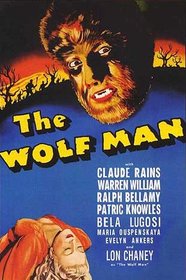Our editor-in-chief Nate Yapp is proud to have contributed to the new book Hidden Horror: A Celebration of 101 Underrated and Overlooked Fright Flicks, edited by Aaron Christensen. Another contributors include Anthony Timpone, B.J. Colangelo, Dave Alexander, Classic-Horror.com's own Robert C. Ring and John W. Bowen. Pick up a copy today from Amazon.com!
The Wolf Man (1941)
In 1941, Universal Pictures released the last of their truly great monster movies, The Wolf Man. Operating in the red most of the thirties, Universal's pocketbook needed a new monster and a new monster star. It had been a decade since the initial box office boom of Dracula, but Bela Lugosi's star had fallen considerably since and he was not considered a bankable lead. Boris Karloff's last picture as a monster was 1939's Son of Frankenstein and he felt he had become too old to play monsters, nor did he want to any longer. Stepping into the shoes worn before both Karloff and Lugosi by his very own father, was Lon Chaney Jr. After displaying considerable acting chops in the widely acclaimed Of Mice and Men and showing the exec's at Universal that he could do horror with Man-Made Monster, he was cast in the role that made him famous, Larry Talbot, the Wolf Man.
The film was shot on what was considered a B-grade budget, but it was certainly not B-grade in its quality. The cast was full of Oscar winners and nominees like Claude Rains (The Invisible Man, Casablanca), highly respected actor's actors like Maria Ouspenskaya, and horror veterans like Ralph Bellamy (Ghost of Frankenstein) and Bela Lugosi. Bellamy was an Oscar nominee, too, if you are keeping track. The cinematography and score are both some of the finest in any of the Universal monster movies and the script by Curt Siodmak was so rich and well written that some of the concepts he invented for the film have taken root in many of our minds as real, old-world werewolf folkore.
The setting of the film is a purposefully ambiguous Euro-British village in a make-believe version of the present (1941). By contrast, in this happy and fictitious setting there is no world-war being waged, as there was in the real world of 1941. Ironically, production of The Wolf Man took place over three weeks in November, wrapping a matter of days before the December 7 attack on Pearl Harbor. The film was intended to be a fairy tale (see the bold, capitalized word LEGEND in the opening shot of a dictionary entry), a complete fiction and total entertainment. I suppose the studio heads at Universal felt that the fictional horrors of The Wolf Man would be at odds with the real horrors of World War II.
As our story opens, Larry Talbot, second son of Sir John Talbot (Claude Rains) is returning to the village of his birth to claim his right as heir to the Talbot fortune and title. Larry had left home to find his own way in America for seventeen years as his older brother was being groomed to become Lord Talbot. A briefly mentioned hunting accident ended his brother's life making Larry the number one son and heir. His stay in America helps explain his lack of British dialect. In Siodmak's original script, Larry's last name was Gill and was an American mechanic installing a telescope in Talbot Castle. Studio heads felt a father-son story line would be more effective and the script was summarily "fixed."
Larry and his father pledge to let their strained relationship be buried in the past as they forged a new, closer father-son bond. Much regret is felt from both Larry and Sir John and the two actors work very comfortably together. No mention is made of Lady Talbot, but I always assumed she was a big, raw-boned gal based upon Larry's size and Sir John's small stature. If you pay close attention, Sir John does refer to a big Talbot ancestor, but if you blink, you miss the moment. Repeated watchings really pay off. It's hard to believe Claude Rains sired Lon Chaney Jr. but the moments between the two actors are so earnest you forget about their physical dissimilarity.
Larry almost immediately becomes smitten with Gwen Conliffe (Evelyn Ankers) the daughter of the village antiques dealer. Chaney and Ankers have wonderful chemistry and appeared in many more films together after The Wolf Man. (Reportedly, the two were never fond of one another based upon their first encounter revolving around Ankers being given Chaney's dressing room. Chaney apparently liked to drink and break things and the studio wanted a more subdued tenant). In the famous scene where Larry and Gwen meet, Larry purchases a silver, wolf-headed cane that would seal his destiny. (Destiny by the way, was the film's working title.)
Larry accompanies Gwen and her hapless friend Jenny to a swingin' gypsy camp outside town to have their fortunes told. Haplessly enough, Jenny is separated from her friends and is attacked by gypsy Bela Lugosi in the form of a wolf. Okay, it was actually a German Shepherd named Moose; they couldn't find a wolf who could act the part. Larry, being the good guy and sympathetic hero type he is, hears Jenny's cries and runs to her aid, beating the "wolf" to death with his cane. In the fray, Bela the Wolf bites Larry.
Enter Maria Ouspenskaya as Maleva, Bela's withered, wrinkled and wise old gypsy mother. Maleva seems to know everything there is about werewolves and dispenses her knowledge with some of Siodmak's best written lines. At this point the character of Maleva becomes the emotional and spiritual mother figure to Claude Rains' father of intellect and reason. One of the best acting moments in the film takes place when Sir John is confronted by Maleva right before the big climax. Emotion and intellect square off in the personages and talents of two of the finest actors in Hollywood at the time. That is certainly not B-grade quality. It also foreshadowed the showdown that was about to occur in Larry's own torn-apart life.
The theme of duality is strong in this Jeckyll and Hyde retelling. Good and evil, love and resentment, tenderness and violence all bubble beneath the surface of Larry Talbot. In the earlier script I mentioned, more emphasis was placed on Larry's psyche. It was unclear in that script whether he was really a werewolf or just believed it to the point of "running around on all fours baying at the moon." Many of the pop-psychology references from the earlier version remained and helped elevate the script beyond a simple rampaging monster story.
By modern standards the makeup for The Wolf Man is a little hokey. It's been said that Lon Chaney Jr. looks more like a wild boar than a wolf. Consider that makeup magician Jack Pierce who was responsible for Frankenstein, the Mummy and many other Universal monsters was working "out of the kit" using materials like yak hair, collodion, spirit gum and cotton, and the makeup becomes more impressive. No cool CGI or even the animatronics used so effectively in An American Werewolf in London were available in 1941. Maybe the largest factor in the appearance of the Wolf Man is censorship. The MPPDA (the MPAA of it's day) would not allow him to look "too" bestial, otherwise we might have seen a radically different werewolf. Maybe one closer to the man-beasts of The Howling. The MPPDA would also not allow direct man-to-wolf transformations. That worked out better for the film because the big transformation scene is saved until it is the most poignant when Larry Talbot dies and goes from wolf-to-man.
"Larry Talbot DIES!? You ruined the whole movie for me!!" Relax. You know you can't keep a good monster down. Larry miraculously survived; in fact he survived to appear in four more films and finally got to play the hero in his final appearance in Abbott and Costello Meet Frankenstein saving pudgy Lou from a fate worse than death. Go Larry!
The Wolf Man is truly one of the greatest horror films of the ages. On the Mt. Rushmore of movie monsters, Larry Talbot would have the Thomas Jefferson spot up there next to Dracula, Frankenstein and The Mummy. By the way, if you are wondering what became of Larry Talbot after his film career was over, he did just fine. He's currently on a shelf in my living room with a freshly stitched shirt, ready and waiting for my little boy to fall in love with him just like his daddy did.









The good son dies and the bad
The good son dies and the bad son returns from America after all these years. Things could have gotten hairy, but it's a bit thinning on top. The story is a little 'disjointed'... I could go on forever with the puns... but no silver bullet from me, although I did like the old fur face when he was using the telescope...
Great commentary track from
Great commentary track from Tom Weaver on the LEGACY series 2 disc edition. Unfortunately, there's a horrible "WOLF MAN" featurette by Stephen Sommers that's essentially an infomercial for VAN HELSING in disguise!
Host of CINEPHOBIA RADIO and the RUE MORGUE PODCAST.
http://www.cinephobia-radio.com
http://www.rue-morgue.com